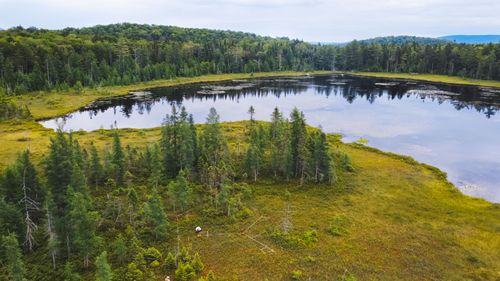The trend in 213 vertebrate population sizes monitored over the long term remained stable between 1970 and 2014.

The Living Planet Index is an indicator developed by the World Wildlife Fund (WWF) and used by the United Nations Convention on Biological Diversity. The global scale evaluation of this indicator is regularly reported in the Living Planet Report. It represents the average change in population size of a set of species monitored over the medium to long term. The trend over the last 44 years shows little systematic change. However, there has been a possible decline in recent years; the average trend for 2014 indicates a decline of 11%, within a confidence interval that ranges from a decline of 39% to growth of 35%. Further population monitoring is required to clarify the trend.
The populations included in this study (only vertebrate fauna) are not necessarily representative of the overall biodiversity of Quebec. The populations studied are biased towards more charismatic species and populations located in southern Quebec. Only a small number of populations monitored north of the 49th parallel are included. The major vertebrate groups are nevertheless represented by data sets for freshwater and saltwater fishes (104 populations), birds (95 populations), mammals (49 populations), amphibians (5 populations). In order to reduce the bias and uncertainty in the calculation of the index, it will be necessary to add more population size time series. This index does not provide information on extinct species or populations.
The Living Planet Index (LPI) measures the overall trend in vertebrate abundance in terrestrial, freshwater and marine systems since 1990. The index presents the average trends in population growth rates, and not the changes in the total number of animals or species.
The index presented here is a calculation applied to data from the most recent Living Planet Report (https://www.wwf.org.uk/our-reports/living-planet-report-2022) extracted for Quebec. The index applies to vertebrate species and suggests that population sizes may be decreasing since 1970, with a very large margin of error.
The size data used for the calculation are located within a 200 km radius of the province's borders, i.e., 1228 populations for 197 species and are limited to species present in Quebec.
Data sources Only vertebrate animal populations are tracked for the index. Time series are extracted from the Living Planet Index Database (LPI, 2022; Living Planet Index database). These time series were selected from datasets from the scientific literature and monitoring organizations for populations whose abundance was measured using a uniform protocol over a period of at least six years, between 1970 and 2014. The reference for the time series can be found at the living planet index portal.
Treatment The Living Planet Index is calculated with the R package “rlpi”, following the standard established by the World Wildlife Fund (WWF) and the Zoological Society of London (ZSL). Methods are detailed in Loh et al (2005). The first step is to account for environmental variability and measurement errors by applying a smoothing procedure to each time series. An annual growth rate is calculated from each corrected series and a geometric mean is calculated over all population trends. The average growth rate, relative to initial population size, is then reported. The uncertainty on the index is a representation of the 95% confidence interval, i.e., the range of values that the index estimate includes 95 times out of 100.
To learn more about the indicator, visit the Living Planet Index website .
LPI 2012. Living Planet Index database. 2022. www.livingplanetindex.org. Downloaded on October 24, 2022.
Loh et al. (2005).The Living Planet Index: using species population time series to track trends in biodiversity. https://royalsocietypublishing.org/doi/10.1098/rstb.2004.1584
"rlpi" R package Zoological-Society-of-London. (2020). rlpi package (beta). https://github.com/Zoological-Society-of-London/rlpi
LPI computation methods Collen, B. et al. (2009). Monitoring Change in Vertebrate Abundance: the Living Planet Index. https://conbio.onlinelibrary.wiley.com/doi/10.1111/j.1523-1739.2008.01117.x
List of Quebec's vertebrate species Gouvernement du québec. (2021). Animaux sauvages du Québec. https://www.quebec.ca/agriculture-environnement-et-ressources-naturelles/faune/animaux-sauvages-quebec

